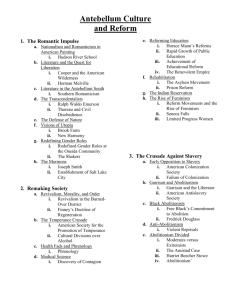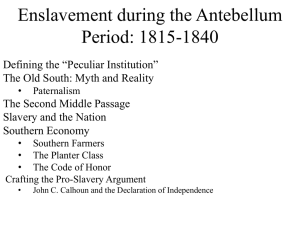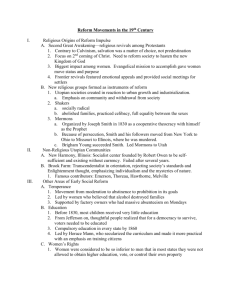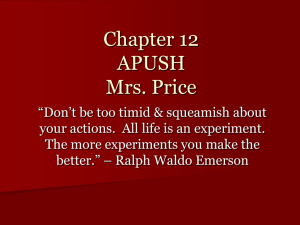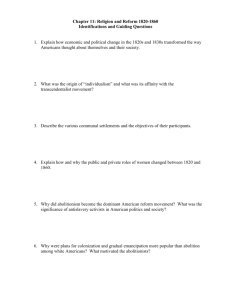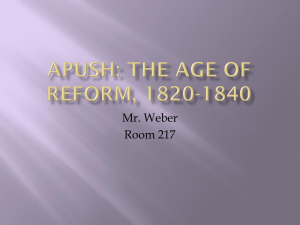H105K: The Pursuit of Perfection
advertisement
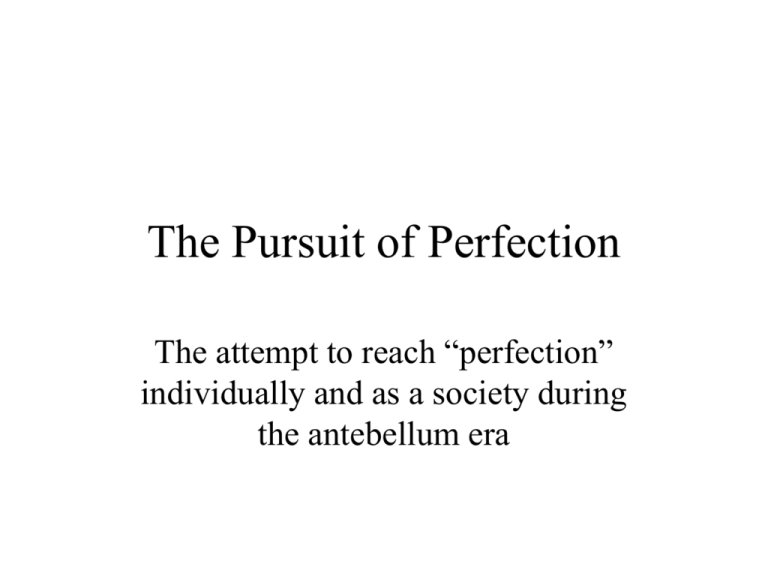
The Pursuit of Perfection The attempt to reach “perfection” individually and as a society during the antebellum era I. The Second Great Awakening A. Causes and Theology • Possible origins of this second major religious revival • “Millennialism” • Free moral agency or “Free will” • This is an Arminian revival, not a Calvinistic one like the first Great Awakening • “Perfectionism” • Competing Religious Belief Systems B. The Frontier Phase • Location: Kentucky frontier • Camp Meeting setting • Bizarre physical behavior • Denominations affected • No impact on societal reform C. The Northern Phase • “Burned-over” District • Less emotional than the frontier • Spawns Reform Societies • Began at Yale College • Ministry of Lyman Beecher • Ministry of Charles Finney II. New Voluntary Associations Produced • Attack on societal evil— religious roots • Attempt to baptize the market revolution • The range of voluntary reform societies • The success of the American Temperance Society • Reform societies used religious techniques to advance their causes III. Changes in the American Family A. Marriage and Gender Issues • The triumph of marriage for love • More affectionate relationships between husbands and wives • The “cult of true womanhood” • Increasing division of the work places -- “doctrine of the two spheres” • An era of deep female friendships B. Parenting and Childhood • The cosmic importance of parenting • Childhood seen as a distinct stage of life • More intimacy between parents and children— especially children and mothers • Smaller families were the norm • 25% drop in family size between 1800 and 1850 IV. Institutional Reform A. Free Public Schools • Free public schools increased dramatically between 1820-1850 • The role of moral indoctrination • The appeal of education to lower classes • Opponents of free public schools • Key leaders in this public education movement B. Special Institutions for Social Misfits • “Perfecting” impulse • Colonial treatment of these “special need” individuals • John Locke’s Tabula Rasa model • Special Antebellum Institutions emerged • Growing problems and important reformers V. The Emergence of Abolitionism • Unachieved “perfection” leads to division within reform societies • Early approaches to ending slavery --American Colonization Society (1817) • William Lloyd Garrison --American Anti-Slavery Society (1833) --The Liberator V. Abolitionism (cont.) • Theodore Weld and the Grimke Sisters • The geography of abolitionism • Internal problems for the American Anti-Slavery Society • Open split in the Society by 1840 • The creation of the Liberty Party (1840) VI. Early American Feminist Movement • Grows out of abolitionism • Important Early Leaders in the Feminist Movement • The Seneca Falls Convention (1848) • Popular signs of protest VII. Radical Experiments in Perfection • Utopian Socialism --Robert Owen • Transcendentalism --Brook Farm (1841) • The “water cure” and the diet of Sylvester Graham • Phrenology • Popularity of Séances and “spirit-rapping”
